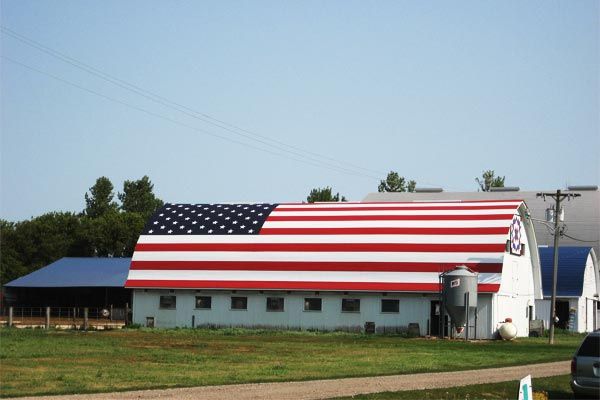Many homeowners choose to paint the American flag on their homes, barns, or garages. The flag can be a powerful symbol of national pride, but there are specific guidelines on how the flag should be represented. This article explores some important flag rules to know before painting it on your property.
Understanding the U.S. Flag Code
The United States Flag Code, established on June 22, 1942, outlines guidelines for properly displaying and handling the American flag. These rules extend to painted representations of the flag, so homeowners should learn about the code before painting one. While the code is not legally binding for civilians, following its recommendations demonstrates respect.
According to the Flag Code, any design that incorporates red, white, and blue with stars and stripes is considered a representation of the American flag. This broad definition means even stylized or abstract interpretations of the flag are subject to the same rules as traditional flag displays.

Key Provisions of the Flag Code
The Flag Code contains several important provisions that apply to painted representations of the flag. These include guidelines on proper positioning, illumination, and maintenance.
1. Properly Illuminate the Flag At Night
One of the most surprising rules regarding the American flag relates to illumination. During daylight hours, flags can be displayed without additional lighting. However, the Flag Code stipulates the flag should be properly illuminated at night if displayed 24 hours a day.
Install outdoor lighting that illuminates the painted flag area. Consider energy-efficient LED spotlights or floodlights that can be directed at the painted surface.
2. Homeowners Associations Can’t Prohibit Flag Displays
The Freedom to Display the American Flag Act of 2005 protects homeowners’ rights to display the American flag on their property. This act prevents homeowners associations (HOAs) from banning flag displays, including painted representations.
While HOAs cannot prohibit it, they may have rules regarding the manner of display. For example, an HOA may restrict the size of painted flags or their placement on the property. Before painting a large flag on your garage door or exterior wall, check your HOA bylaws to ensure compliance and avoid potential conflicts.
3. Maintain the Painted Flag’s Condition
The Flag Code emphasizes the importance of keeping the flag in excellent condition. Painted representations require regular maintenance to preserve the flag’s appearance and integrity.
When painting an outdoor flag, use high-quality, weather-resistant exterior paints. Consider applying a clear protective coating to shield the paint from UV rays, rain, and other environmental factors. This extra step extends the life of your painted flag.
Inspect your painted flag regularly for signs of fading, chipping, or peeling. Address any issues promptly with touch-ups to maintain the flag’s vibrant appearance. Depending on your climate and the paint quality, you may need to repaint the flag every few years to keep it looking its best.
4. Orient the Flag Correctly
The Flag Code states that the flag should be oriented correctly, providing guidelines for both vertical and horizontal flag displays.
When painting a vertical flag, the union (the blue field with stars) must be positioned at the top left corner of the flag. For horizontal flag paintings, the union must be at the upper left corner when viewed from the street or primary viewing angle. These rules apply whether you paint the flag on a wall, garage door, or any other surface.
How To Accurately Paint the American Flag
If you aren’t painting a stylistic version of the American flag, use the correct colors and star and stripe configuration for an accurate representation of this national symbol.
Colors Used in the Flag
Along with white, the flag’s specific shades of red and blue are Old Glory Red and Old Glory Blue. Avoid using different shades or adding additional colors, as this can detract from the flag’s authenticity and meaning.
Proper Star and Stripe Configuration
The flag has 13 stripes and 50 stars. The stars should be arranged in nine alternating rows of six and five stars. The first and last stripes should be red. Consider using painter’s tape techniques to create crisp, uniform stars and stripes.

Tips for Painting Flags on Different Surfaces
Different surfaces require different approaches when painting an American flag. Here are some suggestions for common surfaces:
- Concrete: Clean the concrete first to remove any debris or loose particles. Use a masonry primer to help the paint adhere properly. Apply several coats of exterior paint designed for concrete surfaces.
- Metal: Choose paints formulated for metal to ensure long-lasting results. Clean the metal to remove rust, dirt, or grease, and use a metal primer to prepare the surface for paint.
- Wood: Sand the surface so it’s smooth and ready to receive paint. Use a wood primer before applying the color so the paint adheres well, and seal the paint with a weather-resistant finish.
Creative Flag Display Ideas
A painted American flag can become a focal point of your home’s exterior or interior design. Here are some creative ways to incorporate the flag into your existing decor.
Murals and Large Wall Art
Consider dedicating an entire wall or garage door to a mural of the American flag. If painting the wall itself is daunting, you can paint large canvas panels individually and assemble them on the wall.
Smaller Decorative Elements
Instead of a large mural, you can paint smaller, more subtle flag elements on your property, such as on flower pots, patio furniture, or accent pieces around your garden. This softens the effect while still celebrating your patriotism.
